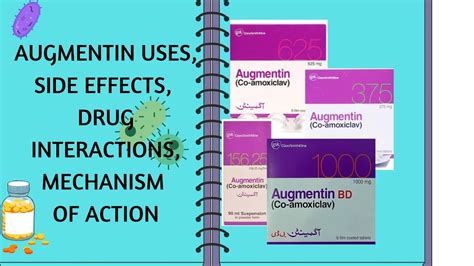Intro
Discover comprehensive Augmentin antibiotic information, including uses, side effects, and dosage. Learn about this amoxicillin-clavulanate combo, its benefits, and potential interactions, for informed treatment decisions.
The use of antibiotics has become a crucial aspect of modern medicine, allowing us to combat bacterial infections that would otherwise be life-threatening. Among the various antibiotics available, Augmentin has emerged as a widely prescribed and effective medication. Understanding the properties, mechanisms, and applications of Augmentin is essential for both medical professionals and patients alike. In this article, we will delve into the world of Augmentin, exploring its composition, benefits, potential side effects, and the importance of responsible use.
Augmentin is a combination antibiotic that consists of two active ingredients: amoxicillin and clavulanic acid. Amoxicillin belongs to the penicillin group of antibiotics, which work by inhibiting the growth of bacterial cell walls, ultimately leading to the death of the bacteria. Clavulanic acid, on the other hand, is a beta-lactamase inhibitor that helps to combat bacteria that have developed resistance to amoxicillin and other penicillins. This synergy between amoxicillin and clavulanic acid makes Augmentin a potent weapon against a broad spectrum of bacterial infections.
The importance of understanding antibiotics like Augmentin cannot be overstated. With the rise of antibiotic resistance, it is crucial that we use these medications judiciously, ensuring their efficacy for generations to come. Moreover, being informed about the benefits and potential side effects of Augmentin enables patients to take an active role in their healthcare, making informed decisions in consultation with their healthcare providers.
Introduction to Augmentin

Augmentin is prescribed for a variety of bacterial infections, including pneumonia, skin infections, and urinary tract infections. Its effectiveness against a wide range of bacteria makes it a versatile antibiotic. However, like all medications, Augmentin should only be used under the guidance of a healthcare professional, as misuse or overuse can lead to adverse effects and contribute to the growing problem of antibiotic resistance.
How Augmentin Works

The mechanism of action of Augmentin involves the inhibition of bacterial cell wall synthesis. Amoxicillin binds to and inhibits penicillin-binding proteins (PBPs) located inside the bacterial cell wall, resulting in a weakened cell wall and ultimately the death of the bacteria. Clavulanic acid protects amoxicillin from degradation by beta-lactamase enzymes, which are produced by certain bacteria to confer resistance to penicillins. This protective effect allows Augmentin to maintain its efficacy against bacteria that would otherwise be resistant to amoxicillin alone.
Benefits of Augmentin
The benefits of Augmentin are numerous, making it a preferred choice for treating bacterial infections. Some of the key advantages include: - Broad spectrum of activity: Augmentin is effective against a wide range of Gram-positive and Gram-negative bacteria. - Synergistic action: The combination of amoxicillin and clavulanic acid enhances the antibiotic's efficacy, particularly against bacteria that produce beta-lactamase enzymes. - Oral administration: Augmentin can be taken orally, which is convenient for patients and often leads to better compliance with treatment regimens. - Availability in various formulations: Augmentin is available in different forms, including tablets, chewable tablets, and a liquid suspension, making it suitable for patients of all ages.Side Effects and Precautions

While Augmentin is generally well-tolerated, it can cause side effects, some of which may be severe. Common side effects include diarrhea, nausea, vomiting, and skin rash. More serious but less common side effects can include severe allergic reactions, Clostridioides difficile (C. diff) infection, and liver dysfunction. It is essential for patients to discuss any concerns or pre-existing conditions with their healthcare provider before starting Augmentin, as certain conditions may require dose adjustments or alternative treatments.
Precautions and Warnings
- Allergic reactions: Patients with a history of allergic reactions to penicillins or other beta-lactam antibiotics should use Augmentin with caution. - Pregnancy and breastfeeding: Augmentin should be used during pregnancy only if clearly needed, and its use during breastfeeding should be discussed with a healthcare provider. - Pediatric use: The safety and efficacy of Augmentin in pediatric patients have been established, but the dosage and formulation may need to be adjusted based on the child's age and weight.Responsible Use of Augmentin

The responsible use of Augmentin and other antibiotics is critical in the fight against antibiotic resistance. This involves:
- Using antibiotics only when prescribed by a healthcare provider.
- Completing the full course of treatment, even if symptoms improve before finishing the medication.
- Not sharing antibiotics with others or using leftover antibiotics for future illnesses.
- Practicing good hygiene and getting vaccinated to prevent infections.
Antibiotic Resistance
Antibiotic resistance occurs when bacteria develop mechanisms to survive the effects of antibiotics, making infections harder to treat. The overuse and misuse of antibiotics, including Augmentin, contribute to this problem. It is essential for both healthcare providers and patients to be aware of the risks of antibiotic resistance and to use these medications judiciously.Conclusion and Future Perspectives

In conclusion, Augmentin is a valuable antibiotic that has been used effectively to treat a wide range of bacterial infections. Its broad spectrum of activity, combined with its availability in various formulations, makes it a preferred choice for many patients. However, the potential for side effects and the critical issue of antibiotic resistance necessitate responsible use and continued vigilance. As we move forward, the development of new antibiotics and the promotion of antibiotic stewardship will be essential in ensuring that these life-saving medications remain effective for future generations.
Final Thoughts
The journey to understanding and utilizing Augmentin effectively involves a collaborative effort between healthcare providers, patients, and the broader community. By fostering a culture of responsible antibiotic use and supporting research into new antimicrobial therapies, we can work towards a future where bacterial infections are managed safely and effectively.What is Augmentin used for?
+Augmentin is used to treat a variety of bacterial infections, including pneumonia, skin infections, and urinary tract infections.
How does Augmentin work?
+Augmentin works by inhibiting the growth of bacterial cell walls through the action of amoxicillin and protecting it from degradation by beta-lactamase enzymes with clavulanic acid.
What are the common side effects of Augmentin?
+Common side effects of Augmentin include diarrhea, nausea, vomiting, and skin rash. More severe side effects can include allergic reactions and liver dysfunction.
We invite you to share your thoughts and experiences with Augmentin, and to engage in a discussion about the responsible use of antibiotics. Your insights and questions are valuable in fostering a community that prioritizes health, safety, and the judicious use of medications. By working together, we can ensure that antibiotics like Augmentin remain effective tools in the fight against bacterial infections for years to come.
